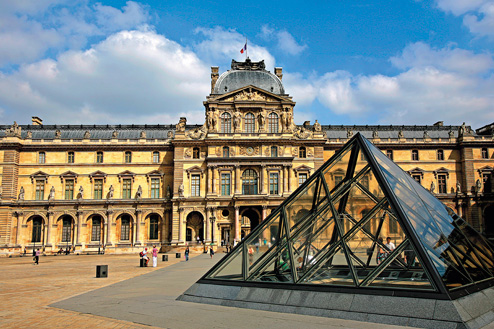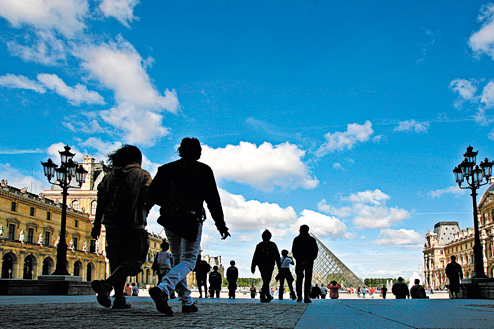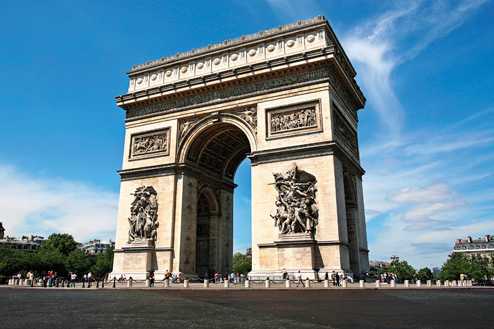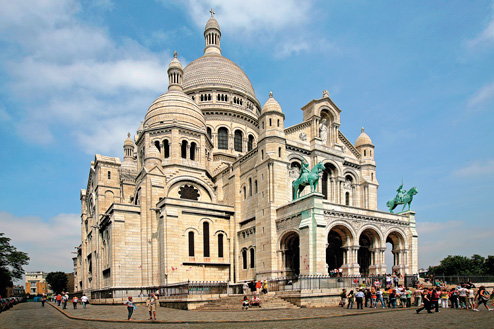Montmartre
Perched atop the Butte Montmartre, Sacré Coeur is the city’s most conspicuous landmark, floating palely into view just when you least expect it. With its artistic heritage and stunning views, the surrounding village attracts tourists by the convoy. But don’t let that deter you from exploring the ‘real’ Montmartre, whose crumbling villas and ivy-clad impasses were the backdrop for Amélie Poulain.
Leaving metro Anvers, head through the Marché St Pierre, popular with young wannabe designers hunting for textiles. From here, it’s an uphill hike through the gardens or a short funicular ride to the basilica of Sacré-Coeur. Begun as a memorial to the losses of the 1870-71 Franco-Prussian War, this Byzantine fantasy wasn’t finished until after the first world war. The domed interior is resplendent with mosaics. Outside, you’ll find the entrance to the spiral staircase where, for a small fee, you can climb to the city’s second highest viewpoint. It’s worth running the gauntlet of artists in place du Tertre, if only to compare it with the authenticity as you head towards Caulaincourt. Surrealism fans may not be able to resist the very commercial Espace Montmartre Salvador Dalí close by. Where rue Saules and Saint-Vincent meet, you’ll find Montmartre’s tiny vineyard, whose un-plummy vintage is celebrated in early October. Also here is the Lapin Agile, whose cabarets have entertained everyone from Apollinaire to Picasso. Worth visiting for its picturesque appeal alone, the Musée de Montmartre was home to the artists Renoir, Dufy, Suzanne Valadon and her son, Maurice Utrillo. rue Lepic, leading down to the village of Abbesses, is pure Amélie territory. Trendy ‘zincs’, one-off shops and a tiled wall declaring love in 300 languages are all reason enough to linger. A short walk west, you can pay your respects to the likes of Berlioz, Degas and the pop diva Dalida at the peaceful Cimitière de Montmartre.
Leaving metro Anvers, head through the Marché St Pierre, popular with young wannabe designers hunting for textiles. From here, it’s an uphill hike through the gardens or a short funicular ride to the basilica of Sacré-Coeur. Begun as a memorial to the losses of the 1870-71 Franco-Prussian War, this Byzantine fantasy wasn’t finished until after the first world war. The domed interior is resplendent with mosaics. Outside, you’ll find the entrance to the spiral staircase where, for a small fee, you can climb to the city’s second highest viewpoint. It’s worth running the gauntlet of artists in place du Tertre, if only to compare it with the authenticity as you head towards Caulaincourt. Surrealism fans may not be able to resist the very commercial Espace Montmartre Salvador Dalí close by. Where rue Saules and Saint-Vincent meet, you’ll find Montmartre’s tiny vineyard, whose un-plummy vintage is celebrated in early October. Also here is the Lapin Agile, whose cabarets have entertained everyone from Apollinaire to Picasso. Worth visiting for its picturesque appeal alone, the Musée de Montmartre was home to the artists Renoir, Dufy, Suzanne Valadon and her son, Maurice Utrillo. rue Lepic, leading down to the village of Abbesses, is pure Amélie territory. Trendy ‘zincs’, one-off shops and a tiled wall declaring love in 300 languages are all reason enough to linger. A short walk west, you can pay your respects to the likes of Berlioz, Degas and the pop diva Dalida at the peaceful Cimitière de Montmartre.













